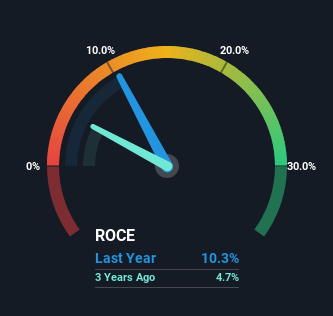- Saudi Arabia
- /
- Healthcare Services
- /
- SASE:4009
Returns On Capital At Middle East Healthcare (TADAWUL:4009) Have Stalled

There are a few key trends to look for if we want to identify the next multi-bagger. Typically, we'll want to notice a trend of growing return on capital employed (ROCE) and alongside that, an expanding base of capital employed. This shows us that it's a compounding machine, able to continually reinvest its earnings back into the business and generate higher returns. So, when we ran our eye over Middle East Healthcare's (TADAWUL:4009) trend of ROCE, we liked what we saw.
What Is Return On Capital Employed (ROCE)?
If you haven't worked with ROCE before, it measures the 'return' (pre-tax profit) a company generates from capital employed in its business. The formula for this calculation on Middle East Healthcare is:
Return on Capital Employed = Earnings Before Interest and Tax (EBIT) ÷ (Total Assets - Current Liabilities)
0.10 = ر.س313m ÷ (ر.س5.0b - ر.س2.0b) (Based on the trailing twelve months to September 2023).
So, Middle East Healthcare has an ROCE of 10%. In absolute terms, that's a pretty standard return but compared to the Healthcare industry average it falls behind.
See our latest analysis for Middle East Healthcare

In the above chart we have measured Middle East Healthcare's prior ROCE against its prior performance, but the future is arguably more important. If you'd like, you can check out the forecasts from the analysts covering Middle East Healthcare here for free.
What Can We Tell From Middle East Healthcare's ROCE Trend?
The trend of ROCE doesn't stand out much, but returns on a whole are decent. The company has consistently earned 10% for the last five years, and the capital employed within the business has risen 56% in that time. Since 10% is a moderate ROCE though, it's good to see a business can continue to reinvest at these decent rates of return. Over long periods of time, returns like these might not be too exciting, but with consistency they can pay off in terms of share price returns.
Another point to note, we noticed the company has increased current liabilities over the last five years. This is intriguing because if current liabilities hadn't increased to 39% of total assets, this reported ROCE would probably be less than10% because total capital employed would be higher.The 10% ROCE could be even lower if current liabilities weren't 39% of total assets, because the the formula would show a larger base of total capital employed. So while current liabilities isn't high right now, keep an eye out in case it increases further, because this can introduce some elements of risk.
What We Can Learn From Middle East Healthcare's ROCE
In the end, Middle East Healthcare has proven its ability to adequately reinvest capital at good rates of return. On top of that, the stock has rewarded shareholders with a remarkable 321% return to those who've held over the last five years. So while the positive underlying trends may be accounted for by investors, we still think this stock is worth looking into further.
Middle East Healthcare does have some risks, we noticed 2 warning signs (and 1 which shouldn't be ignored) we think you should know about.
While Middle East Healthcare may not currently earn the highest returns, we've compiled a list of companies that currently earn more than 25% return on equity. Check out this free list here.
New: Manage All Your Stock Portfolios in One Place
We've created the ultimate portfolio companion for stock investors, and it's free.
• Connect an unlimited number of Portfolios and see your total in one currency
• Be alerted to new Warning Signs or Risks via email or mobile
• Track the Fair Value of your stocks
Have feedback on this article? Concerned about the content? Get in touch with us directly. Alternatively, email editorial-team (at) simplywallst.com.
This article by Simply Wall St is general in nature. We provide commentary based on historical data and analyst forecasts only using an unbiased methodology and our articles are not intended to be financial advice. It does not constitute a recommendation to buy or sell any stock, and does not take account of your objectives, or your financial situation. We aim to bring you long-term focused analysis driven by fundamental data. Note that our analysis may not factor in the latest price-sensitive company announcements or qualitative material. Simply Wall St has no position in any stocks mentioned.
About SASE:4009
Middle East Healthcare
A healthcare provider, owns and operates a network of hospitals under the Saudi German Hospital name in the Middle East and North Africa.
Very undervalued with proven track record.
Market Insights
Community Narratives



